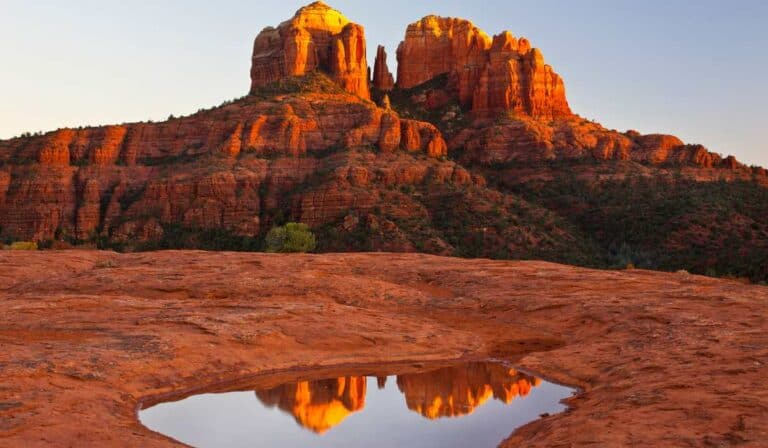Discover the Best Hiking Trails in Southern Vermont
Exploring the majestic hiking trails of Southern Vermont can be an energizing and enriching experience. Traversing the diverse topography of Southern Vermont, from rolling hills to soaring mountains, is sure to please all levels of hikers.
In this comprehensive guide, we’ll delve into some of the most remarkable southern Vermont hikes that cater to various skill levels and interests. We’ll also provide essential information on planning your hike, packing appropriately for your adventure, navigating the trails with ease, and soaking in the stunning beauty of Vermont’s landscapes.
Furthermore, we’ll discuss important safety considerations while exploring these enchanting trails and offer recommendations on nearby accommodations for a comfortable stay after a day of trekking through Southern Vermont’s breathtaking wilderness.
Table of Contents
1. Exploring the Best Hiking Trails in Southern Vermont

Discover the best hiking trails in Southern Vermont, from easy strolls to challenging treks. This idyllic area provides a variety of terrain and scenery for hikers of all aptitudes to relish. From easy strolls through lush forests to adrenaline-pumping climbs up steep mountain slopes, Southern Vermont has something for hikers of all levels.
The Long Trail
The Long Trail is one of the most famous hiking trails in Vermont, stretching over 270 miles from the Massachusetts border to Canada. In southern Vermont, this trail offers numerous day hikes and overnight backpacking trips with stunning views of Green Mountain National Forest.
Glastenbury Mountain Loop
- Distance: 22.6 miles (round trip)
- Elevation Gain: 4,100 feet
- Dog-friendly? Yes (on leash)
- Terrain: Moderate-to-difficult wooded terrain with some rocky sections and gradual inclines.
This loop hike takes you through dense forests and past serene ponds before reaching Glastenbury Mountain’s summit at 3,748 feet. Enjoy panoramic views of southern Vermont as well as opportunities for wildlife sightings such as deer and moose along your journey.
Mt Equinox via Blue Summit Trail
- Distance: 7.5 miles (round trip)
- Elevation Gain: 3,000 feet
- Dog-friendly? Yes (on leash)
- Terrain: Moderate to difficult with steep inclines and rocky sections.
The Blue Summit Trail leads you to the highest peak in southern Vermont, Mt Equinox at 3,848 feet. The trail offers a challenging hike through dense forests and open meadows before reaching the summit’s breathtaking views of the surrounding valleys and mountain ranges.
Pine Cobble Trail to Appalachian Trail
- Distance: 6 miles (round trip)
- Elevation Gain: 1,600 feet
- Dog-friendly? Yes (on leash)
- Terrain: Easy to moderate with some rocky sections and gradual inclines.
This scenic trail begins in Massachusetts but quickly crosses into Southern Vermont as it connects Pine Cobble Trail to the famous Appalachian Trail. Enjoy beautiful views of Williamstown Valley along this relatively easy hike that is perfect for beginners or those looking for a leisurely day out on the trails.
Sweet Pond State Park Loop
- Distance: 4.5 miles (round trip)
- Elevation Gain: Minimal elevation gain
- Dog-friendly? Yes (on leash)
- Terrain: Easy to moderate with some rocky sections and gradual inclines.
Located in Southern Vermont’s Emerald Lake State Park, the Sweet Pond Loop offers a peaceful hike around a serene pond with opportunities for birdwatching and wildlife sightings. This easy hike is perfect for families or those looking for a relaxing day out in nature.
Venturing out to discover the magnificent trails of Southern Vermont is an exhilarating opportunity to immerse oneself in nature and marvel at its grandeur. Prior to your excursion, it is advisable to investigate the trails and ascertain that you are able to make the most of your exploration.
Key Points To Remember:
Discover the best hiking trails in Southern Vermont, from easy strolls to challenging treks. The Long Trail offers numerous day hikes and overnight backpacking trips with stunning views of Green Mountain National Forest while Glastenbury Mountain Loop takes you through dense forests and past serene ponds before reaching its summit at 3,748 feet.
Click here to read about How Many Miles Should You Hike
2. Planning Your Hike
Before setting out, planning ahead is key to ensuring a safe and enjoyable journey through Southern Vermont’s hiking trails. From choosing the right trail to checking weather conditions, proper planning will ensure you make the most of your time in nature.
Selecting the Right Trail
To begin with, select a trail that matches your fitness level and interests. Southern Vermont offers a variety of hiking trails, ranging from easy strolls to challenging treks. Consider factors such as distance, elevation gain, and technical difficulty when making your decision. If you’re new to hiking or looking for a family-friendly option, start with an easier trail before working up to more challenging hikes.
- Easy: West River Trail – A scenic riverside walk perfect for beginners or families with young children.
- Moderate: Lye Brook Falls Trail – A beautiful hike leading to one of Vermont’s tallest waterfalls.
- Challenging: Stratton Mountain via Long Trail/Appalachian Trail – A rewarding trek offering stunning views from the summit fire tower.
Gathering Information about Your Chosen Trail
Prioritize gathering information about your chosen trail by researching online resources like SunWaterDirt.com or consulting guidebooks and local experts at outdoor stores in nearby towns. Be sure to note any specific regulations regarding pets or camping along the route if applicable.
Additionally, check recent hiker reviews on platforms like Hiking Project. These can provide valuable insights into current trail conditions, potential hazards, and seasonal highlights such as wildflower blooms or fall foliage.
Checking Weather Conditions
Before embarking on your hike, monitor the weather forecast to be prepared for a range of conditions. Southern Vermont’s climate can be unpredictable, so it is essential to prepare for a range of conditions. In addition to checking local forecasts, consider downloading a reliable weather app like National Weather Service for real-time updates while you’re on the trail.
Remember that mountainous areas often experience more extreme weather than lower elevations; plan accordingly by packing extra layers and rain gear even if clear skies are predicted.
Informing Someone About Your Plans
Last but not least, always inform someone about your hiking plans before heading out. Share details such as your chosen trailhead location, planned route, and expected return time with a friend or family member who will not be joining you on the hike. This way they can alert authorities in case of an emergency if you fail to check in at the designated time.
By taking these steps during the planning stages of your Southern Vermont hiking adventure, you can ensure safety and enjoyment throughout this incredible outdoor experience.
Planning your hike is an important step in ensuring a successful and enjoyable experience. Preparing thoroughly is essential for a successful and enjoyable hike; having the right equipment can make your journey secure and comfortable. Now let’s take a look at what items should be packed for this adventure.
Key Points To Remember:
Plan ahead for a safe and enjoyable hike in Southern Vermont by selecting the right trail, gathering information about it, checking weather conditions, and informing someone about your plans. Consider factors such as distance, elevation gain, and technical difficulty when choosing a trail that matches your fitness level and interests. Don’t forget to pack extra layers and rain gear even if clear skies are predicted because mountainous areas often experience more extreme weather than lower elevations.
3. Packing for Your Trip

Before embarking on your Southern Vermont hiking adventure, it’s essential to pack the right gear and supplies. Having everything you need will ensure a safe and enjoyable experience on the trails. To ensure a successful journey, we’ll go over what items should be packed and how to do it effectively.
A. Essential Hiking Gear
The following is a list of must-have items for any hiking trip:
- Backpack: Choose one that fits comfortably and has enough space for all your gear.
- Hiking boots or shoes: Ensure they are comfortable, supportive, and broken in before hitting the trail.
- Clothing layers: Dress appropriately for the weather conditions with moisture-wicking materials and extra layers if needed.
- Hat & sunglasses: Protect yourself from sun exposure during long hikes.
- Rain gear: A lightweight rain jacket or poncho can be a lifesaver when unexpected showers hit while out on the trail.
B. Navigation Tools & Safety Items
In addition to essential hiking gear, consider bringing these navigation tools and safety items as well:
- Map & compass: Familiarize yourself with the trail and always carry a map and compass as backup navigation tools.
- Whistle: A whistle can be used to signal for help in case of an emergency.
- Headlamp or flashlight: Bring extra batteries, especially if you plan on hiking during dusk or dawn hours.
C. Food, Water & Personal Items
Last but not least, don’t forget these essential personal items for your hike:
- Water bottle or hydration system: Stay hydrated by carrying enough water for the duration of your hike. Southern Vermont trails may have limited access to potable water sources along the way.
- Snacks & lunch: Pack high-energy snacks like nuts, dried fruit, granola bars, and nutritious lunch to keep you fueled throughout your adventure.
Packing efficiently is key when preparing for a day out on the trails. Make sure all heavy items are placed close to your back and centered in your backpack. Distribute weight evenly between both sides of the pack so that it feels balanced while walking. Finally, store frequently accessed items such as maps and snacks near the top or in outer pockets for easy access during breaks.
In addition to packing smartly before hitting those beautiful Southern Vermont hiking trails, check out SunWaterDirt.com’s favorite spots, including Vermont’s Mighty Monadnock, Black Mountain, and Jamaica State Park easy hikes. Don’t forget to wear sturdy hiking shoes and bring a detailed trail map, especially when exploring Vermont’s unpredictable weather.
With thousands of trails crisscrossing Southern Vermont, you’re sure to find great trails year-round, including the West Cliff Trail, Lye Brook Falls Trail, and the Lake Shaftsbury State Park Rail Trail. Visit Windam Hill Pinnacle Association for awesome rail trail hikes, and explore the Southern Green Mountains with the Green Mountain National Forest Summit Trails and the Emerald Lake Trails. Whether you’re hiking in Southwestern Vermont, Southeastern Vermont, or South Central Vermont, there’s a trail for everyone in Vermont’s favorite towns.
Before hitting the trails, make sure to bring along all the necessary supplies for your journey. Now that you’re ready to go, let’s explore some of the best hiking trails in Southern Vermont and how to navigate them.
Key Points To Remember:
Before embarking on a Southern Vermont hiking adventure, pack essential gear like a comfortable backpack, supportive shoes or boots, and clothing layers appropriate for the weather. Additionally, bring navigation tools such as maps and compasses along with safety items including whistles and headlamps. Before setting off, make sure to bring sufficient refreshments and nourishment for your trek.
Click here to read about Explore Easy Hikes in South Lake Tahoe
4. Navigating the Trails
When exploring the Southern Vermont region, it is important to be able to traverse the trails correctly in order to maximize your enjoyment of nature. In this section, we’ll provide tips on using a map and compass, understanding trail markers, and staying on track during your hike.
Using a Map and Compass
A reliable topographic map of the area is an invaluable tool for any hiker. It will show you important features such as elevation changes, water sources, and landmarks that can help guide your way. Familiarize yourself with how to read a topographic map before heading out on your hike.
In addition to a map, carrying a compass is crucial for navigating through unfamiliar terrain accurately. Learn basic compass skills, including taking bearings and orienting yourself with surrounding landmarks.
Understanding Trail Markers
Southern Vermont trails are often marked by colored blazes painted or nailed onto trees along the path. These markings serve as guides for hikers to follow throughout their journey:
- Single blaze: Indicates that you’re on the correct path.
- Double blaze: Signals an upcoming change in direction or intersection with another trail; pay close attention here.
- Different color blaze: This represents different trail systems within one area – make sure you’re following the right color for your intended route.
It’s essential to be aware of these trail markers and follow them closely, as they’ll help you stay on track during your hike.
Staying on Track
While navigating the trails in Southern Vermont, it’s crucial to remain vigilant and pay attention to your surroundings. Here are some tips for staying on track:
- Maintain a steady pace: Don’t rush through your hike; instead, maintain a consistent speed that allows you to observe the environment around you.
- Avoid shortcuts: Stick to marked trails even if they seem longer or more challenging – cutting corners can lead to getting lost or damaging sensitive ecosystems.
- Check-in with fellow hikers: If hiking with others, communicate regularly about navigation decisions and make sure everyone is on the same page.
Navigating the beautiful hiking trails in Southern Vermont can be an enjoyable experience when done correctly. By using a map and compass, understanding trail markers, and staying focused throughout your journey, you’ll have an unforgettable adventure exploring this stunning region.
Navigating the trails in Southern Vermont can be a challenging yet rewarding experience. With that said, it is time to move on and explore the beauty of nature found along these paths. Enjoying Nature’s Beauty offers hikers an opportunity to appreciate all the wonders this region has to offer.
Key Points To Remember:
To fully enjoy hiking in Southern Vermont, it’s important to know how to navigate the trails properly. This section provides tips on using a map and compass, understanding trail markers, and staying on track during your hike. By maintaining a steady pace, avoiding shortcuts, and communicating with fellow hikers about navigation decisions, you can have an unforgettable adventure exploring this stunning region.
5. Enjoying Nature’s Beauty

Exploring the scenic wonders of Southern Vermont’s hiking trails can be a captivating experience. From colorful wildflowers to majestic wildlife, there are countless wonders waiting for you on these trails. In this section, we’ll explore some of the natural highlights that make hiking in Southern Vermont a truly unforgettable experience.
Wildflower Wonders
Southern Vermont boasts an impressive array of wildflowers, which can be found blooming along many popular hiking trails throughout spring and summer months. Some species you might encounter include:
- Trilliums
- Lady’s slippers
- Columbines
- Wild geraniums
- Asters
To ensure these delicate beauties continue thriving for future generations to enjoy, remember always to practice Leave No Trace principles and avoid picking or trampling on flowers.
Fascinating Wildlife Encounters
Hiking through Southern Vermont also offers plenty of opportunities for spotting fascinating wildlife. Keep your eyes peeled as you traverse various habitats – from lush forests to open meadows – and you may catch sight of animals such as:
- Moose, which are often seen grazing near wetlands or forest edges
- White-tailed deer, which are common throughout the region
- Black bears, though sightings are rare, it’s important to be aware of their presence and take necessary precautions
- Migratory songbirds, such as warblers and thrushes, fill the air with their melodious tunes during the spring and summer months
To increase your chances of spotting wildlife while hiking in Southern Vermont, consider investing in a pair of binoculars or a camera with a zoom lens. Remember always to observe animals from a safe distance and never approach or feed them.
Breathtaking Scenery
Awe-inspiring sights abound in Southern Vermont, ranging from majestic mountains to tranquil lakeshores. From panoramic mountain vistas to serene lakeshores, these landscapes provide an idyllic backdrop for your outdoor adventures. Some must-see natural landmarks include:
- The summit views from Mount Equinox
- The cascading waters of Hamilton Falls
- The pristine shores of Emerald Lake State Park
No matter which path you take, the captivating scenery of Southern Vermont will surely stay with you forever.
To ensure a pleasant experience, safety should be the primary concern when admiring nature’s beauty. Prior planning, cognizance of the environment, and appreciation for potential hazards are all necessary to ensure safety on a trail.
Key Points To Remember:
Exploring the Southern Vermont region provides a unique opportunity to revel in nature’s splendor, featuring an array of blooms and animals like moose, deer, black bears, and birds. The breathtaking scenery includes panoramic mountain vistas from Mount Equinox, cascading waters of Hamilton Falls, and the pristine shores of Emerald Lake State Park.
Click here to read about Discover the Best Hiking Trails in Southern Vermont
6. Staying Safe on the Trail
When embarking on an adventure through Southern Vermont’s beautiful hiking trails, it is essential to prioritize safety. By following some simple guidelines and being prepared for potential hazards, you can ensure a fun and enjoyable experience in nature.
Avoiding Dangerous Animals and Plants
Southern Vermont is home to various wildlife species that may pose risks if not approached with caution. Be aware of black bears, moose and timber rattlesnakes as they may pose risks if not approached with caution. To avoid encounters with these creatures:
- Maintain a safe distance from any wildlife you encounter.
- Make noise while hiking to alert animals of your presence.
- Store food properly at campsites or when taking breaks along the trail.
- If you come across a snake, give it plenty of space and slowly back away without making sudden movements.
In addition to potentially dangerous animals, there are also plants that can cause discomfort or harm if touched or ingested. Poison ivy is common in this region; learn how to identify its characteristic three-leaf pattern so you can steer clear of it during your hike.
Being Aware of Your Surroundings
Paying attention to your surroundings while hiking in Southern Vermont will help keep both yourself and others safe on the trail:
- Trail etiquette, such as yielding the right-of-way.
- Weather conditions: Prior to your journey, take a look at the weather predictions and be ready for any abrupt alterations in temperature or precipitation.
- Be conscious of potential risks, like slippery stones, sharp inclines, and unsteady land. Always stay on designated trails to minimize risks.
Carrying Essential Safety Gear
Having the right safety gear with you can make all the difference in an emergency situation:
- A first aid kit with essentials like band-aids, gauze pads, tweezers, and pain relievers.
- A whistle to signal for help if needed.
- Navigation tools, including a map and compass or GPS device.
- A headlamp or flashlight with extra batteries.
- A multi-tool or pocket knife for various tasks and repairs along the trail.
By taking these precautions while hiking in Southern Vermont’s beautiful landscapes, you’ll ensure a safe and enjoyable experience exploring nature’s wonders.
It is essential to be vigilant and practice safety measures while out on the path. With that in mind, it’s time to explore where you can stay when visiting these amazing trails in Southern Vermont.
Key Points To Remember:
When hiking in Southern Vermont, it’s important to prioritize safety by being aware of your surroundings and carrying essential safety gear. To avoid dangerous encounters with wildlife or plants, maintain a safe distance and learn how to identify potential hazards. By taking these precautions, you can ensure an enjoyable experience exploring nature’s wonders.
7. Finding Accommodations Nearby

After a tiring day of trekking and discovering the stunning trails in Southern Vermont, you’ll need to find somewhere cozy to relax and recharge for your next excursion. Luckily, there are various accommodations available nearby to suit every preference and budget. From cozy campgrounds to luxurious hotels and resorts, here’s how you can find the perfect lodging option for your trip.
Campgrounds
For a unique and rustic getaway, camping is an ideal lodging option. For a genuine nature experience, look into camping at one of the numerous campgrounds near popular hiking trails that provide basic services like bathrooms, picnic spots, and fire pits. Some recommended campgrounds in Southern Vermont include:
Hotels & Inns
If camping isn’t quite your style or if you prefer more comfort after a tiring hike, consider booking a room at one of the many charming hotels or inns scattered throughout Southern Vermont. These establishments often provide additional amenities like Wi-Fi access, breakfast options, or even spa services so that guests can unwind after their adventures on the trail.
- The Manchester View
- Kimpton Taconic Hotel
- Wilburton Inn
Bed & Breakfasts and Airbnb Rentals
For a more personalized experience, consider staying at one of the many bed & breakfasts or renting an Airbnb property in Southern Vermont. These options often provide a unique atmosphere and allow you to connect with locals who can share their knowledge about the area’s best hiking trails and hidden gems.
- Airbnb rentals in Southern Vermont
- The Deerhill Inn – West Dover, VT
- Hill Farm Inn – Sunderland, VT
No matter your preference for accommodations, it’s essential to book early during peak seasons like summer and fall foliage time when lodging options fill up quickly. By finding the perfect place to stay after exploring Southern Vermont’s incredible hiking trails, you’ll ensure that your outdoor adventure is both memorable and comfortable.
Key Points To Remember:
After a tiring hike in the Green Mountain State, it’s essential to locate an ideal spot for some much-needed R&R. From cozy campgrounds to luxurious hotels and resorts, there are various accommodations available nearby to suit every preference and budget. It’s important to book early during peak seasons like summer and fall foliage time when lodging options fill up quickly.
Click here to read about Discover the Best Hiking Jackets for Women
FAQs About Hiking Trails in Southern Vermont
What is the Longest Hiking Trail in Vermont?
The Long Trail, which spans 272 miles from the Massachusetts border to Canada, is Vermont’s longest hiking trail. Established by the Green Mountain Club in 1910, it traverses rugged terrain and offers stunning views of Vermont’s natural beauty. Learn more about The Long Trail here.
Does Vermont Have Good Hiking Trails?
Vermont boasts an extensive network of excellent hiking trails suitable for all skill levels. From challenging mountain peaks like Mount Mansfield to scenic paths such as the Robert Frost Interpretive Trail, there are plenty of options for outdoor enthusiasts. Explore some popular hikes in Vermont here.
What is the Hardest Mountain to Hike in Vermont?
Camel’s Hump is considered one of the most challenging mountains to hike in Vermont due to its steep inclines and rocky terrain. Standing at 4,083 feet tall, this distinctive peak offers breathtaking panoramic views upon reaching its summit. Find out more about Camel’s Hump State Park here.
What State is Ranked #1 for Hiking?
Rankings can vary depending on personal preferences and criteria used; however, Colorado consistently ranks high among hikers due to its diverse landscapes and abundance of trails ranging from easy strolls to challenging climbs up iconic fourteeners (peaks over 14k ft). Discover more about hiking in Colorado here.
Conclusion
In conclusion, Southern Vermont offers some of the best hiking trails in New England. From easy hikes to challenging summit trails, there is something for every level of hiker. With detailed trail maps and recommendations from locals, planning your hike and navigating the trails has never been easier.
Explore the stunning natural beauty of Southern Vermont on one of its numerous hiking trails. Don’t forget to pack sturdy shoes and stay safe by following proper hiking protocols. Book accommodations nearby to make the most out of your trip.
If you’re looking for an adventure that combines hiking with yoga, meditation or other wellness practices, check out SunWaterDirt. Retreats from SunWaterDirt are the perfect way to reconnect with nature and yourself, offering unique opportunities for hiking, yoga, meditation, and other wellness activities.







